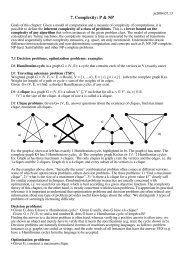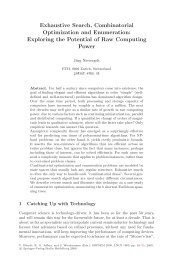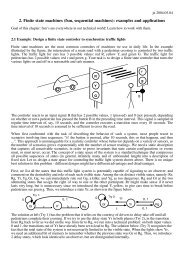8. Equivalence of TMs, PMs and Markov algorithms - Jn.inf.ethz.ch
8. Equivalence of TMs, PMs and Markov algorithms - Jn.inf.ethz.ch
8. Equivalence of TMs, PMs and Markov algorithms - Jn.inf.ethz.ch
You also want an ePaper? Increase the reach of your titles
YUMPU automatically turns print PDFs into web optimized ePapers that Google loves.
in any order.Move a newly created <strong>ch</strong>aracter to the right:1) α 0 0 -> 0 α 0, α 0 1 -> 1 α 0, α 0 # -> # α 0, α 1 0 -> 0 α 1, α 1 1 ->1 α 1, α 1 # -> # α 12) α -> εRules for starting state q: 3) q 0 -> z α 0 , q 1 -> y α 1 , q # ¬ # (terminating rule)Rules for state z: 4) z 0 -> z, z 1 -> y α 1, z # ¬ # (terminating rule)Rules for state y: 5) y 1 -> y, y 0 -> z α 0, y # ¬ # (terminating rule)Initialization: 6) ε -> qExecution trace on the input 1 1 0 1 1 # with result 1 0 1 #.1 1 0 1 1 # Rule 6 applies6) q 1 1 0 1 1 # Rule 3 applies3) y α 1 1 0 1 1 # Rule 1 applies repeatedly, denoted by 1)*1)* y 1 0 1 1 # α 12) y 1 0 1 1 # 15) y 0 1 1 # 15) z α 0 1 1 # 11)* z 1 1 # 1 α 02) z 1 1 # 1 04) y α 1 1 # 1 01)* y 1 # 1 0 α 12) y 1 # 1 0 15) y # 1 0 15) 1 0 1 #Explanation <strong>of</strong> the rules. Every transition <strong>of</strong> the form q, u -> q’, v <strong>of</strong> a Post ma<strong>ch</strong>ine, when executed, causes acorresponding <strong>Markov</strong> rule <strong>of</strong> the form q u -> q’ α v to be executed. The only difference between these two is thatthe Post ma<strong>ch</strong>ine appends v at the right end, whereas the <strong>Markov</strong> algorithm inserts v towards the left end <strong>of</strong> the datastring. Therefore, the <strong>Markov</strong> rule generates a marker α whose task it is to push v to the far right. The rulesinvolving α have top priority, so that the right shift <strong>of</strong> v gets finished before any new Post transition is simulated.<strong>8.</strong>5 Post ma<strong>ch</strong>ine simulates Turing ma<strong>ch</strong>ineLet the TM M have the alphabet A = { 0, 1, }, where the angular brackets are used to delimit the finite portion<strong>of</strong> the tape that initially contains the input, <strong>and</strong> later gets exp<strong>and</strong>ed to delimit that portion <strong>of</strong> the tape that has beenvisited so far. Let the M’s transition function be <strong>of</strong> the form f: Q x A -> Q x A x { L, R }.We sket<strong>ch</strong> the design <strong>of</strong> a Post ma<strong>ch</strong>ine P that simulates M using the alphabet B = { 0, 1, , # }. The basic ideais straightforward, the details are intricate <strong>and</strong> will be skipped.Consider a configuration where M is in state q <strong>and</strong> currently reads the (bold) symbol x <strong>of</strong> the tape:M: < B y x z C >, with y, x, z ∈ A <strong>and</strong> B, C ∈ A*. That is, we focus attention on what happens to x <strong>and</strong> to its twoneigbor symbols y to the left <strong>and</strong> z to the right, <strong>and</strong> merely carry along the remaining portions <strong>of</strong> the tape, B <strong>and</strong> C.In this configuration, M executes eithera move-right transition q, x -> q’ x’ R or a move-left transition q, x -> q’ x’ LThe Post ma<strong>ch</strong>ine P’s state space includes a subspace that is in 1-to-1 correspondence with the state space Q <strong>of</strong> theTM M. Without danger <strong>of</strong> confusion, we call this subspace Q <strong>and</strong> designate its states with the same label as thecorresponding state <strong>of</strong> M. When refering to a state q, the context will make it clear whether we mean the state q M <strong>of</strong>M or q P <strong>of</strong> P. P’s state space includes additional states, to be introduced as needed, because in general a singletransition <strong>of</strong> M requires a sequence <strong>of</strong> transition s <strong>of</strong> P.







![CV [PDF]](https://img.yumpu.com/5256601/1/184x260/cv-pdf.jpg?quality=85)